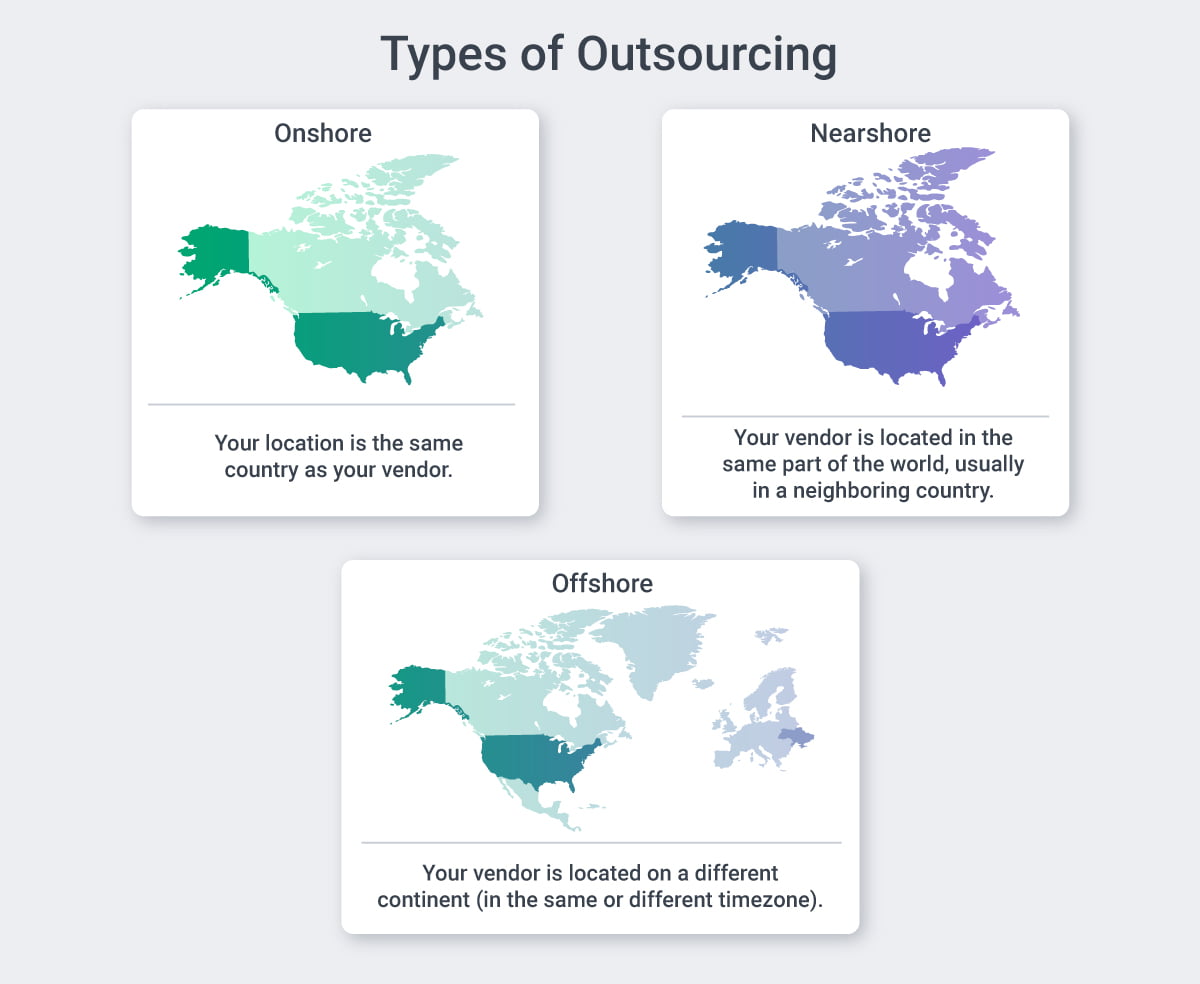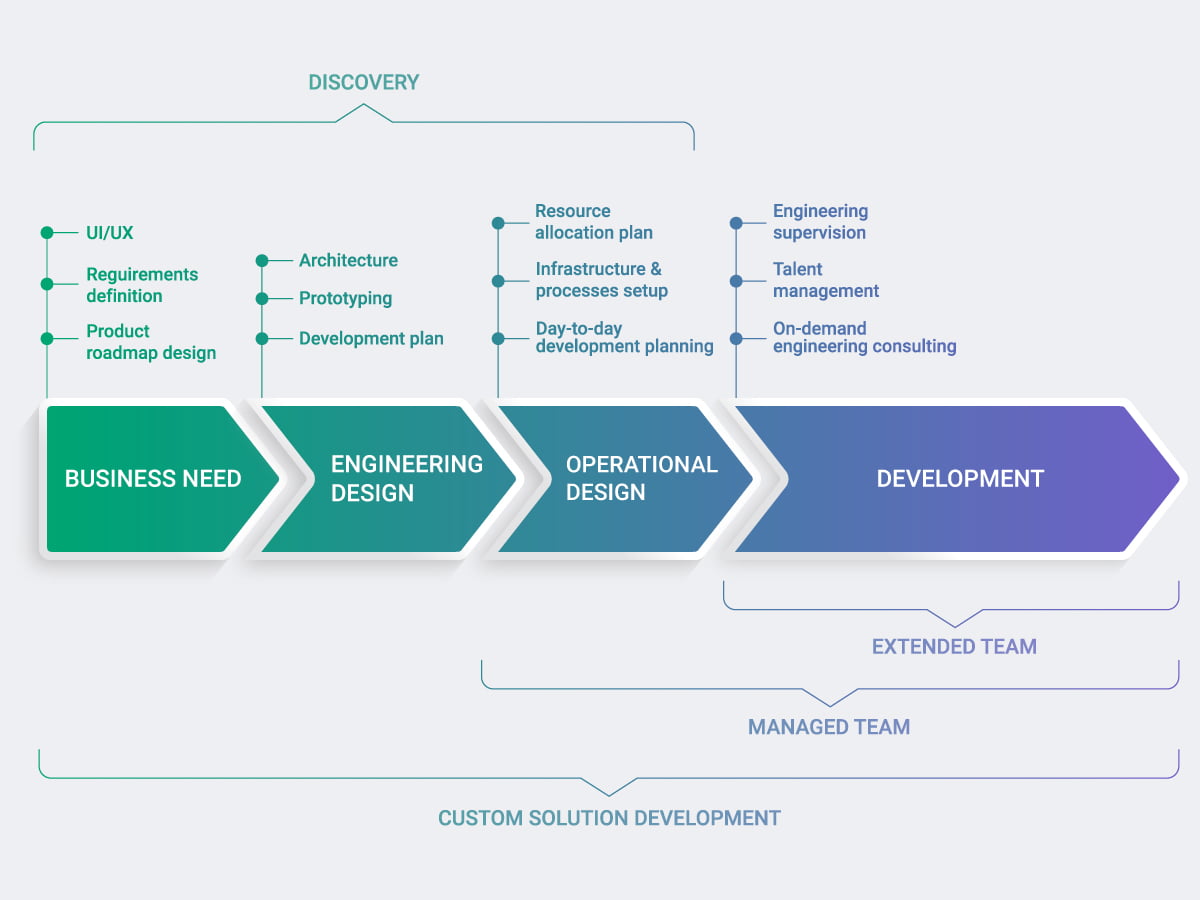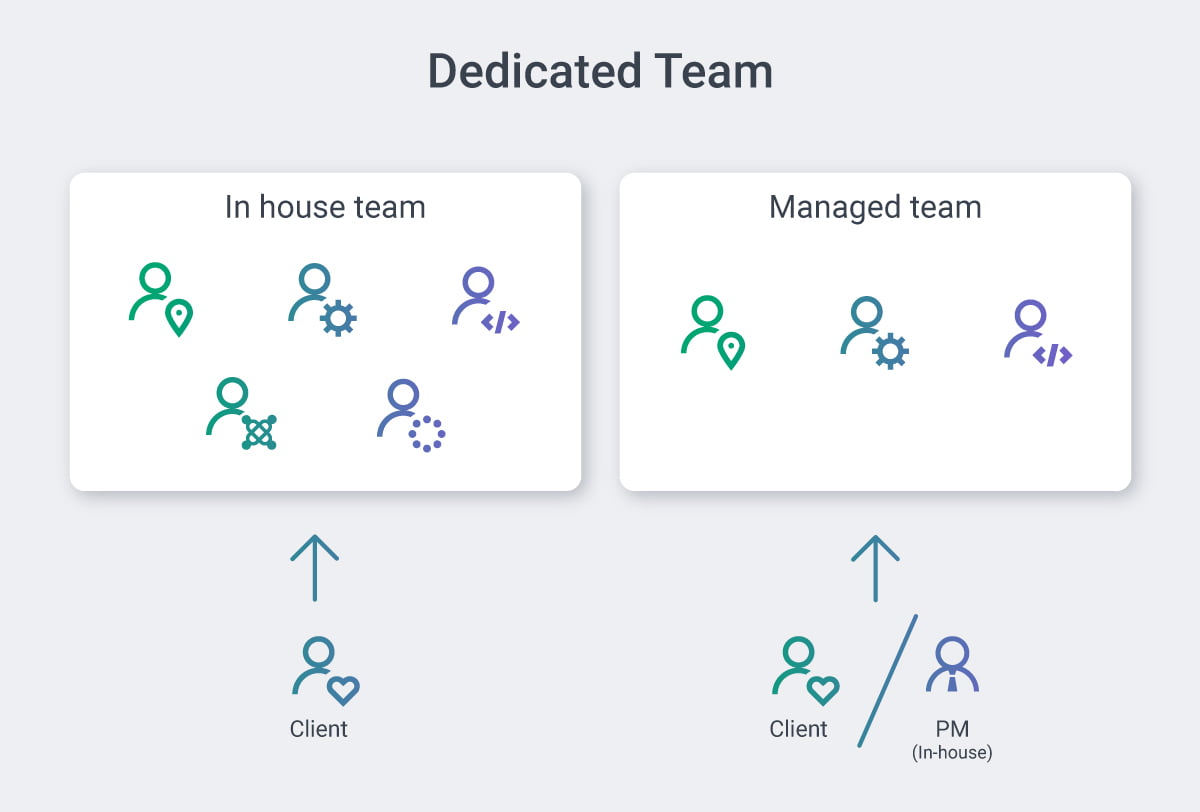Updated: 9/9/2022
Just ten years ago, technology providers were seen as a useful tool to save on development costs and were limited to simple and repetitive projects. Today, remote work looks a lot different as technology providers have evolved to become providers of fully-digitized operations, with the ability to work on big projects and consult in very specific domains and niches where they have unparalleled industry experience.
Many of them have gathered talented developers with unique skills who can offer deep knowledge and expertise on many technologies.
Companies are spending more than ever on business processes and up to $230 billion to manage them. And what is the main culprit of these costs? Talent sourcing.
Many companies, SMEs, and entrepreneurs are having incredible amounts of trouble finding tech specialists and accessing expert talent pools, yet their projects depend heavily on specific technical skills. This is the defining reason why partnering with a tech provider has become more in demand in recent years.
Working with a technology provider comes with a myriad of benefits if you choose the right type, but outsourcing projects can also bring some confusion when it comes to choosing which model is best to handle your business.
In this article, we will highlight the advantages and disadvantages of three different models of remote work: dedicated team, fixed price, and time and materials. Additionally, we have included the most common roadblocks and issues companies face when hiring remote workers. By the end, you will be armed with all the knowledge you need to make a smart decision about partnering with a technology provider.

What is the Origin of Remote Work?
This year, the global tech market will increase and outpace its pre-pandemic growth. According to a report from Forrester, we will see the global tech market grow by 6% growth in 2022 and 2023, with North America and Asia on top, since they are predicted to recover faster than others and rebalance tech portfolios to adjust to the market's needs.
This growth is fueled by a rise in outsourcing, especially since industry leaders have been more vocal in acknowledging the normalcy and benefits of remote work. With the widespread change in remote working globally, a large number of companies worldwide are hiring third-parties to lower their development costs, improve efficiency, and simply deliver their projects faster.
The most common uses of outsourcing include:
- Moving operations to another location to lower development costs
- Speeding up project delivery
- Filling talent gaps
What are the Advantages of Outsourcing
No matter the size of the business you decide to work with, contracting out development or operational tasks can bring a variety of benefits. Here are some of the biggest advantages of hiring an outsourced team.
Task prioritization. Outsourcing can help companies refocus their internal resources on more important tasks for the company’s profitability.
Reduced costs. The expenses of getting a bigger office, purchasing new equipment, and hiring local people can be significant, especially for SMEs. Instead of expanding operations internally, it makes more sense in many cases to outsource.
Team flexibility. When it comes to team management, outsourcing allows different departments to bring additional resources when and where they are needed. Additional flexibility lets you always have the right people working on the core product.
Additional Client Support. Outsourcing allows you to have teams working in multiple time zones, so you can provide support to clients at any time of the day. Nearshore support can help you have technical advisers around during peak hours, and by hiring offshore talent, you can provide 24/7 support to your clients.
Increased efficiency. Companies are not always quick to change business processes or implement new ways of doing things. Using an outsourced team can serve as a tool to drive change or even start an enterprise-level transformation. Third-party teams are used to working with a variety of companies, so they are adaptable to your company’s work procedures and quickly get up-to-speed.
Access to a pool of experts and a different tech stack. When a company doesn’t possess development expertise or have access to skilled professionals for a particular software, hiring a team trained for a certain technology can save you valuable resources and speed up the project significantly.
What Are The Challenges of Outsourcing?
While outsourcing can enrich teams and projects, it has some shortcomings. Here’s what we’ve noticed as potential challenges of IT outsourcing.
Lack of control over the project. Depending on the type of collaboration, vendors can have more or less control over the project. One of the best ways to choose the level of control you want and get everyone on the same page is by carefully selecting the right engagement model for your project, whether it be having a dedicated team or a fixed bid. Choosing wisely what type of outsourcing and what comes with it helps everyone know where responsibilities lie at any time.
Unexpected costs. When using outsourcing for your business, make sure to take into account unplanned expenses. Depending on the complexity of the project, estimates can be quite precise, but it is a good practice to leave a bit of wiggle room for additional consulting, extending the project, or adding extra features.
Cultural barriers. Interactions between employees should always be professional and efficient. Although there may differing work ethics between countries, an experienced, external team should be equipped to work professionally with any company and highly adaptable to collaborate with ease. It is important to check if the outsourcing company you choose has positive reviews from past clients and has a similar working style to yours.
Potential quality problems. Deliverables are one of the key aspects of any project. Distance doesn’t need to be a problem as long as both sides are well informed about the project's status and openly communicate its progress. However, without clear communication and outlined deliverables, there is more room for error.
Quality of teams can differ between outsourcing companies, so it is crucial to make sure the third-party company you choose has the industry expertise and experience you need to provide excellent solutions.

Location-Based Versus Relationship-Based Outsourcing
There are two main overarching types of outsourcing: location-based and relationship-based. The main difference is whether there is more of a focus on the remote team’s location or the type of relationship a company has with the outsourced team.
Location-based outsourcing, also called onshore development, means both teams are in the same country. Developers and teams can be located in different cities, but they all speak the same language.
In some countries, onshore development makes sense if the development costs are similar in the base-country, and thus no need to hire a team in a different country. However, if you want to develop something complex and can’t afford developers who are considerably more expensive, hiring a team from another country might be the best way to go.
Nearshore development is a smart solution for clients that want to employ a team with similar working hours but at potentially better rates. For example, our teams from Brazil work with clients from Canada and the US, and our teams from Ukraine give support to clients from Europe and the Middle East. If you would like to be provided 24/7 support, then hiring a team from a different timezone than your own might be a wise decision as well.
Offshore development means that a client and remote team are not residing in the same country, and may be from a completely different timezone. For example, if a company is located in Silicon Valley, it is possible to hire skilled developers and tech experts from Ukraine, Poland, or Albania, with less cost than hiring locally for a project.
In all of these models, our best advice is to make sure your outsourced team provides an experienced Project Manager who understands how remote communication and asynchronous work function. With a clear communication plan to keep everyone in the loop during various project phases, every project can be successful, affordable, and completed in record time.
Relationship-Based Development Models
Forging a strong, professional relationship between teams is at the core of effectively utilizing a third-party company. Today, there are three popular relationship-based models for outsourcing: Team Augmentation, Managed teams, and Project-Based teams.
Team augmentation works perfectly for a company that wants to expand its in-house team temporarily, by acquiring a few IT specialists. Companies that prefer the team augmentation model usually lack in-house specialists for a certain type of work, such as migrations or app and website rewrites.
When there’s insufficient time to hire experts locally, companies can hire an external team ready to jump in and support their in-house team. Most often, one person or a small team from the hiring company will be in charge of the project and will manage the external and internal team members.
A managed team is one of the best ways to improve operational efficiency since it allows a company to delegate a part of a project to an external team. Usually, a full team of experts works on a project under the hiring company’s management, and their services are priced in a fixed way, varying according to the amount of work done. The greatest benefit of working with a managed team is that the overall price is based on project outcomes, so the vendor has more control over expenses.
Project-Based teams work best for companies that wish to assign a project completely to an outside team. If a project doesn’t need in-house expertise, it can be fully outsourced. However, project-based outsourcing also means that any change to the project must be requested. This model works best for short-term, full-cycle projects.

Choosing the Right Engagement Model
When we start a collaboration with our clients, the first thing we advise them to do is to create an outline of their product’s development based on all documentation they have available. With a clear scope of work, it becomes much easier to choose the right type of engagement model for a project.
Depending on the unique aspects of their project and how much control they want to have, Softjourn clients, can select from three outsourcing models: fixed bid, dedicated team, and time and materials.
Fixed bid is very straightforward; you pay a predefined cost based on the time and effort necessary to finish the project, usually estimated ahead of time. This method works best when a vision of the software and development needs are clear and unlikely to change
Dedicated Team is a model in which a client hires an external team of IT experts to carry out specific tasks separate from their own workers, so their in-house team can focus on other activities. This is usually the best and fastest way for companies to bring on a team of experts with specialized skills their project requires, without having to hire new employees.
Time and Materials is a model that fits well for anyone outsourcing Agile projects which tend to be very flexible. When the scope of work is likely to change on the go, the team size and focus might also frequently change during the project.
In the next section, we outline greater details of these engagement models and our insights on determining which one is the best for your project. Our consultants can also point you in the right direction and help you decide which type of collaboration would work best for your individual case.
The Fixed Bid Model
What is a Fixed Bid Project?
The fixed bid project involves a vendor committing to a set amount of money for a project with defined deliverables. When a company has specific elements in their project, such as predetermined data, a fixed scope, or a strict budget, this model is typically preferred.
A Fixed Bid project is charged as a single, flat fee, irrespective of hours spent. This fee might be for the entire project or allocated to specific weeks or months. Given that Fixed Bid projects operate based on duration, they necessitate a defined start and end date.
When Do You Need a Fixed Bid Model?
Fixed bid contracts are useful for short-term engagements and small to medium-sized projects that can be developed in several iterations and within a fixed budget. They are also useful for developing an MVP for a new product within a precise time frame.
Fixed bid works well for projects with clear goals, deadlines, and specific requirements. For projects based on unverified assumptions and unknown aspects that might take a lot of time, this collaborative model won’t be as effective as hiring a dedicated team. However, for stable projects without much variability and with many last-minute changes, a fixed bid model is your best bet.
Fixed Bid is most suitable for:
- Medium-sized projects with many iterations
- Developing MVP
- Projects with strict deadlines
What Are the Benefits and Challenges of Having a Fixed Bid Team?
Benefits:
- The budget is agreed upon before contract signing
- Deliverables are clearly outlined
- A PM will coordinate the project
Challenges:
- Preparation needed for fixed bid projects is often lengthy
- Communication between teams may be less strong for fast, short-term projects
- There is only minor control over the process from the client’s side
Best Practices for Fixed Bid
A Fixed Bid engagement model is best suited for projects with a well-defined scope, budget, and timeline. It involves the development company quoting a fixed price for the project and committing to deliver the agreed-upon scope within a predetermined schedule. In this section, we'll delve into best practices for maximizing the benefits of the Fixed Bid model.
Clear Communication and Understanding of Project Scope
- Ensure that all stakeholders, including the software development company and the client, clearly understand the project scope.
- Establish a common language and terminology to avoid misunderstandings and ensure everyone is on the same page.
- Encourage open communication channels for regular updates, discussions, and any necessary clarifications.
Risk Management and Mitigation
- Collaboratively identify potential risks at the beginning of the project and develop a risk management plan.
- Allocate contingency budgets and time for unexpected issues that may arise during the project.
- Continuously monitor risks throughout the project and update the risk management plan as needed, with input from both the development company and the client.
Change Control Process
- Develop a well-defined change control process to handle scope changes while keeping all parties informed.
- Communicate the impact of scope changes on the budget and timeline to all stakeholders, including the client and development team.
- Obtain approvals for scope changes and update the project plan accordingly, ensuring transparency and consensus.
The Dedicated Team Model
A managed or dedicated team is a model in which a company hires a team of IT experts from a third-party to work on specialized tasks that their own team either doesn’t have time or expertise to carry out.
Rather than take the time to hire individual experts, bringing on a dedicated team is often the fastest and most affordable way to bridge a talent gap. The company will often have their in-house team, which is augmented with third-party experts and even a PM to collaborate on a project.
A dedicated team falls somewhere between staff augmentation and traditional outsourcing. The dedicated team is permanently assigned to a long-term project, and their sole task is to work on it for a certain time.
The dedicated team model works well for companies that already have established development teams and internal processes, but need domain-dedicated experts.

When Do You Need a Dedicated Team Model?
Dedicated team members work independently from the in-house team, but often have meetings to discuss and clarify goals and collaborate on solutions. Most dedicated teams include a PM and a team of developers with the expertise requested by the client. The project manager reports to the client’s PM or CTO.
A dedicated team works best when you need people for specific tasks, especially if the in-house team is busy with other big projects. A dedicated team will work on side projects, pieces of a larger effort, or anything that will help make the overall development faster.
Dedicated Teams are most suitable for:
- Longer projects
- Agile projects
- Projects with clear initial assumptions and requirements
What are the Benefits and Challenges of having a Dedicated Team?
Benefits of hiring a dedicated team:
- Increased control over the process
- Working with domain experts
- Easier altering of the scope of work
- The outsourced team may feel like an in-house team
- Reduced risks
- Better communication and transparency
- Improved time and people management
Challenges of hiring a dedicated team:
- Not suitable for short projects
- Team needs to have a backlog of tasks
- For certain projects it can take time to find and hire the right people
Best Practices for Dedicated Team
The Dedicated Team model is an excellent choice for long-term projects or when continuous development and maintenance are required. It involves a software development company assigning a team of professionals to work exclusively on the client's project. This section will outline the best practices for setting up a successful dedicated team and ensuring a smooth collaboration between the client and the development company.
Team Selection and Onboarding
- Work together with the client to carefully select team members based on their skills, experience, and cultural fit.
- Provide comprehensive onboarding and training to ensure team members understand the client's processes, tools, and expectations.
- Establish a clear team structure with defined roles and responsibilities, with input from both the development company and the client.
Performance Monitoring and Feedback
- Set performance metrics and goals for the dedicated team in collaboration with the client.
- Conduct regular performance reviews and provide constructive feedback, incorporating client perspectives.
- Encourage a culture of continuous improvement and learning, fostering a positive and collaborative environment.
Ongoing Communication and Collaboration
- Maintain open and transparent communication channels with the dedicated team, the software development company, and the client.
- Schedule regular meetings and status updates to keep everyone informed and aligned with project objectives.
- Encourage a collaborative environment where team members can share ideas and work together to solve problems, with support from both the client and the development company.
The Time and Materials Model
Time and Materials is a project-based model that works best for companies with limited resources. This type of collaboration is most common in outsourcing as it's very convenient, flexible, and easily adaptable for a variety of projects without a clear scope of work.
This type of pricing model means that a software development company bills clients only for the hours and days worked. It’s also possible to add the cost of hardware and software licenses used during the process.
The time and materials model is used for raw project concepts with flexible workflows. When it comes to setting up a budget, a final cost might significantly differ from the estimated cost, and payments are often arranged monthly according to work performed.
When Do You Need a Time and Materials Model?
For startups and SMEs, this model works well when they need to build and deploy a digital product. The time and materials model is well-suited for projects with changing requirements, and products whose requirements haven’t been specified or depend on trends in the market.
Compared to the fixed price model, time and materials offer more flexibility in both price and project scope. For bigger companies, outsourcing development for a certain product or a small project helps their in-house teams have time to focus on other important tasks.
Time and Materials are most suitable for:
- Projects with changing requirements
- Projects that demand flexibility
- Building prototypes
What Are the Benefits and Challenges of the Time and Materials Approach?
Benefits:
- Flexible approach to development
- Scalability and rapid adaptation
- Controlled cost and budget flexibility
- Flexible time management
Challenges:
- Imprecise budget estimates
- Limited accountability
- Lower level of participation and communication than other models
Best Practices for Time and Materials
For projects with a dynamic scope or where flexibility is crucial, the Time and Materials model offers a pay-as-you-go pricing structure based on actual work completed. This model provides the ability to adjust the project's requirements and timeline as needed. In this section, we'll discuss best practices for managing Time and Materials projects effectively while fostering open communication and trust-building between clients and development companies.
Regular Progress Tracking and Reporting
- Implement a project management tool to track progress, tasks, and resources, ensuring visibility for both the development company and the client.
- Conduct regular progress meetings to discuss updates, issues, and concerns, keeping lines of communication open and honest.
- To maintain trust and collaboration, provide transparent reporting to stakeholders, including budget and timeline updates.
Effective Project Management
- Assign a skilled project manager to oversee the project and ensure alignment with objectives, considering both the development company's and the client's perspectives.
- Apply project management methodologies, such as Agile or Scrum, to adapt to changes and deliver results in a flexible manner.
- Manage project scope and priorities to avoid scope creep and ensure a successful outcome, with input and agreement from both the client and the development company.
Open Communication and Trust-Building
- Foster a culture of open communication and transparency between the client and the software development company.
- Establish trust by delivering consistent results and demonstrating expertise while actively seeking client feedback and input.
- Address concerns and challenges proactively to maintain a positive working relationship and promote a successful partnership.
Fixed Bid vs. Dedicated Team vs. Time and Materials
Deciding which of the three models to choose largely depends on the length and complexity of your project. For short projects, we suggest the fixed bid model. As we previously mentioned, this type of model demands well-designed and documented project requirements.
On the other hand, a dedicated team would be a good fit if your project demands more time or a team of domain-dedicated experts is needed for the project.
The Time & Materials model offers enough flexibility to allow clients to change project directions, method of work, and the overall scope of work. You would benefit from a Time and Materials approach if you want to use agile development and your project has to remain flexible.
| Engagement Models: Fixed Bid vs. Dedicated Team vs. Time & Materials | |||
|---|---|---|---|
| Fixed Bid | Dedicated Team | Time & Materials | |
| Project size | Small to medium | Large | Medium to large |
| Project duration | Short to average | Long | Average to long |
| Level of control | Low | High | Medium |
| Project requirements | Defined | Subject to change | Subject to change |
| Final product | Clear | Unclear | Unclear |
| Level of flexibility | Low | High | High |
| Tech stack | Planned | Not fixed | Situational |
| Team scalability | Low | Medium | High |
3 Engagement Models for Software Development. Comparison Table.
How to Choose the Most Suitable Outsourcing Model for Your Project
Some businesses think about outsourcing in terms of saving resources or decreasing development costs. However, outsourcing can help you achieve so much more than that. As your business grows, outsourcing can be a good way to promote innovation and gain access to new skills and tech stacks that can give you a competitive edge.
When companies focus on the value of the contractor's experience and domain knowledge and how much it adds to the overall project, they understand why outsourcing is a unique opportunity. If you are wondering how to find a model that best suits your project, the best place to start is by understanding what you need from the outsourced team.
Depending on the specifics of the project, you must weigh the benefits and pitfalls of each approach, and how they will impact your project. Each outsourcing model works well for certain types of projects and the choice between a dedicated team vs fixed price vs time and materials is tightly connected to your project’s needs.
Choosing between different models of outsourcing is not a decision to be hasty about, but with our helpful information on the benefits and challenges of each, we hope to make the best choice will be made a little easier. Using remote software development services can offer companies a host of benefits, including reduced costs, team flexibility, increased efficiency, reduced risk, and a competitive advantage.
If you are having a hard time choosing between engagement options, our experienced consultants can help you anticipate what problems might arise and advise you on what outsourcing model best suits your project.




